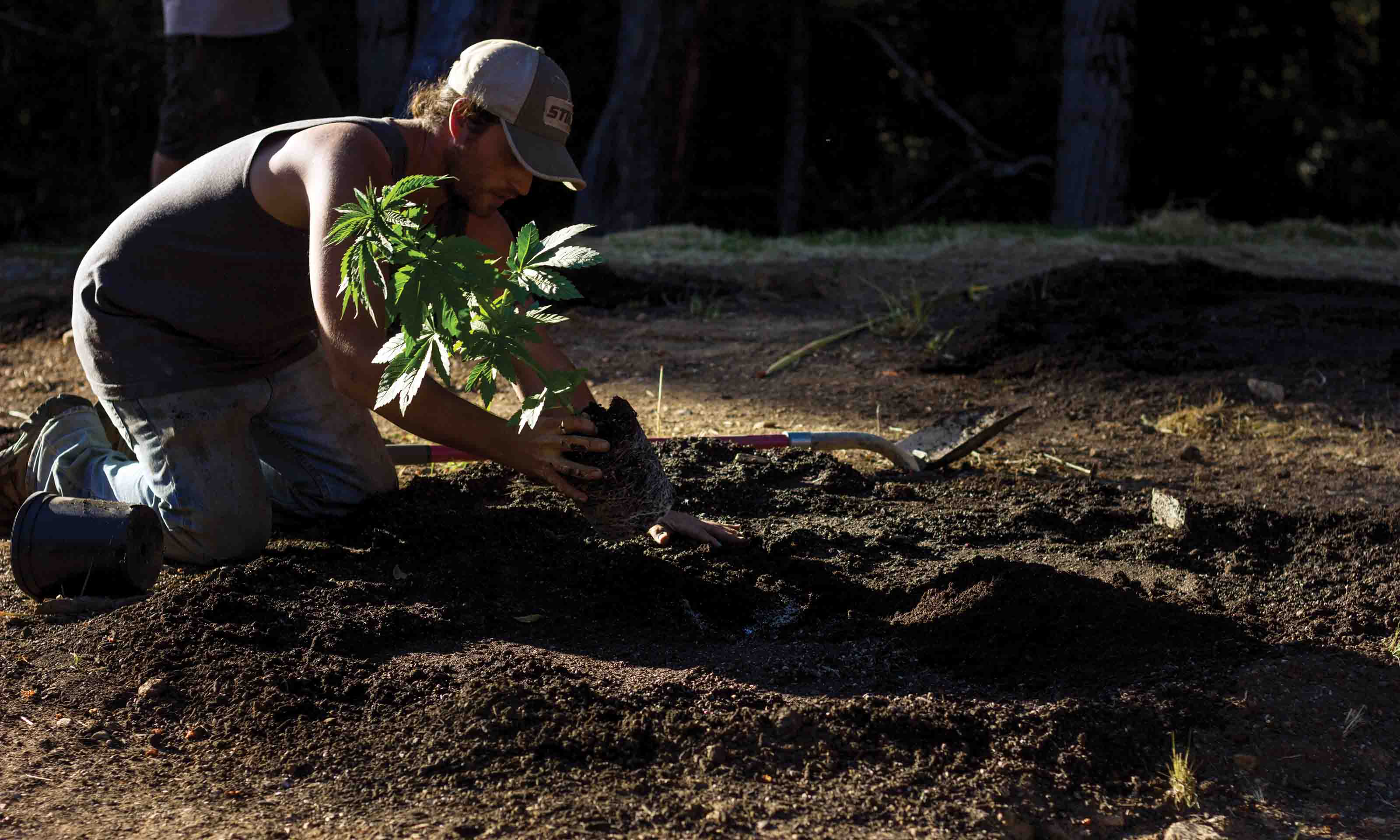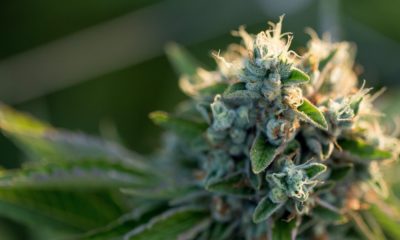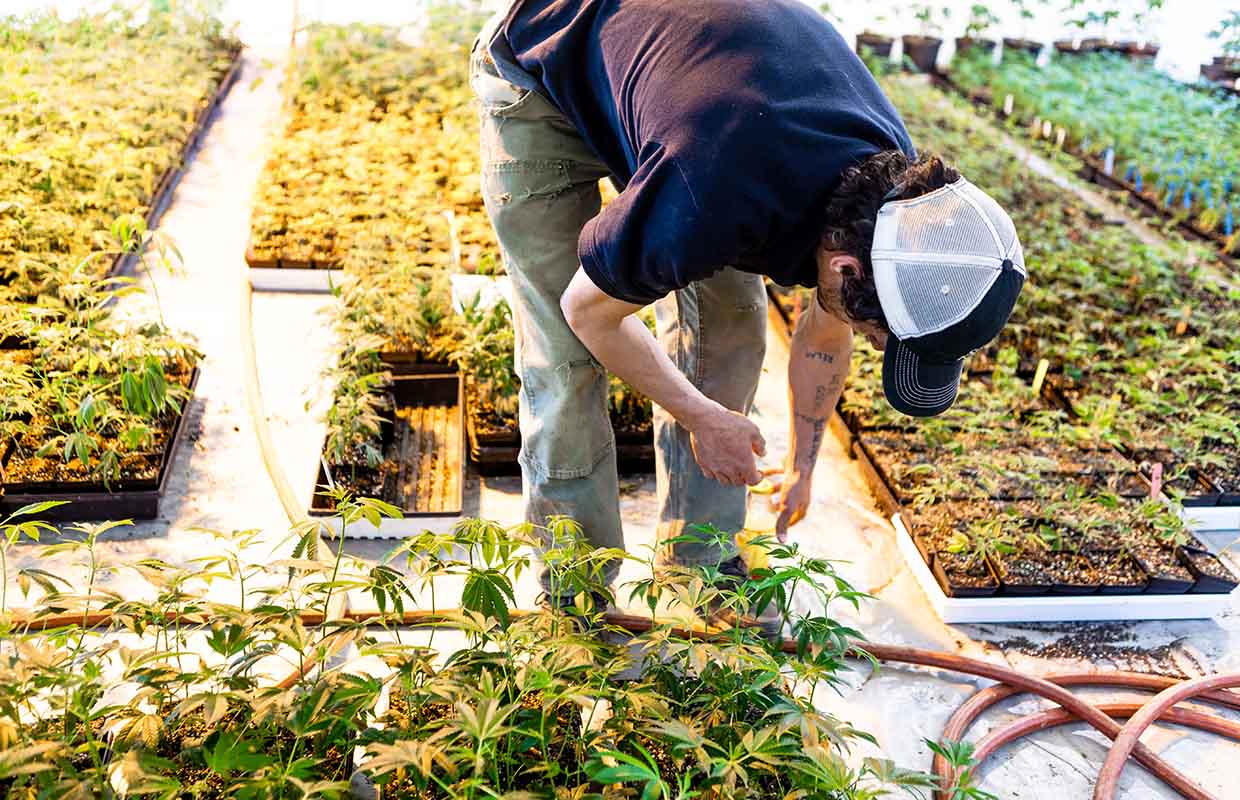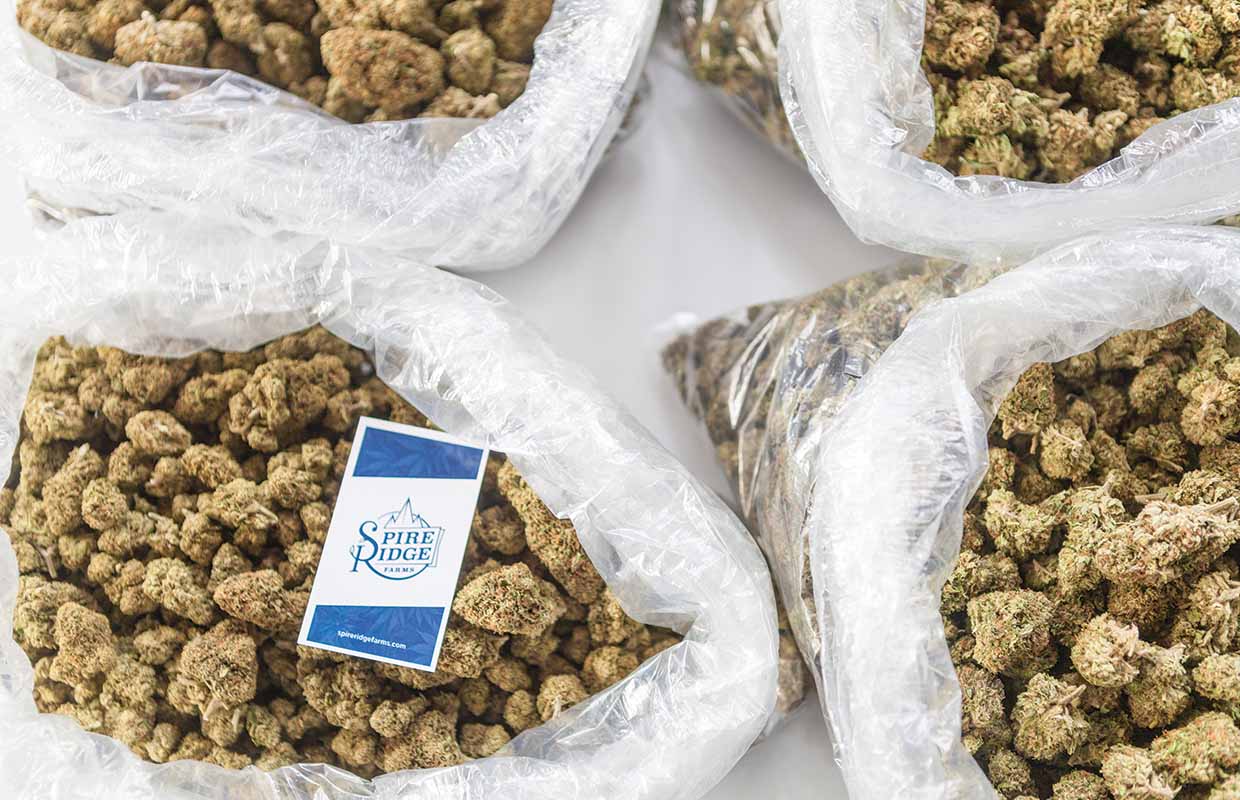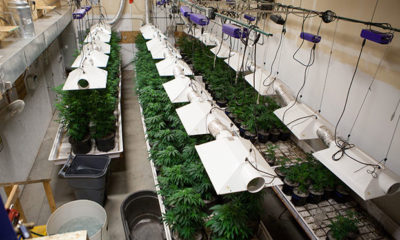Hunting Big Buds in Bigfoot Country
Traditional cannabis cultivators continue to put in the dirty work for the cannabis industry.
I cling fast to the battered bed of an earth-spattered pickup truck as my guide deftly tools it down a narrow, unpaved road carved into the slippery cliff edge of a muddy mountain ridge — in reverse at full speed.
He chats with me casually through the open back window, as if his high-speed automotive acrobatics are as normal as walking. I furiously scribble notes and puff fresh organic cannabis grown from the same warm earth that rises with the mist to meet my eager nostrils. I’m somewhere in the wild woods of Willow Creek, California, at the meeting point of Humboldt and Trinity Counties. I have come here, to the beating heart of the world-famous Emerald Triangle, to hunt legends.
This is Bigfoot country, a fact advertised at regular intervals throughout the small town, from the shameless accumulation of Sasquatch souvenir shops and tourist traps to the explicit theme of our lodging for this adventure: the Bigfoot Motel. Here, we’ve booked the “suite” — a cozy cabin with a kitchenette, one bedroom and a wrought iron Bigfoot cage on the side of the patio opposite the charcoal grill.
And it isn’t just a gimmick — or if it is, it’s one the locals are deeply committed to keeping up. Scratch the generally polite surface of nearly any Willow Creek resident and you’ll find a Sasquatch story.
My guide for this excursion, Kyle Walton of Spire Ridge Farms, is no exception. He shares his theory as he effortlessly tools the sturdy blue pickup around a rain-slicked hairpin turn at full speed with all the interest of a man folding his socks.
“Look, nothing can hide in these woods for that long. People have been out here looking for Bigfoot for years. If it was a big ape or something it would have been found by now,” he says. “So my best guess is that it’s some kind of inter-dimensional alien. That’s why you see it but then can’t find it here afterwards.”
But the aliens I’m here to see aren’t reality-bending proto-apes or pre-evolutionary hominids. I’m here for the flagship flowers of a new cannabis brand carrying a very old torch in the Willow Creek way: Spire Ridge Farms
With house strain names like Alien, Space Wrangler, Halley’s Comet, Abduction OG and U.F.O.G, the farm’s branding promises an otherworldly cannabis experience. And as I spend the day zooming from one part of the ridge to the next — soaking in the scope, size and sophistication of this remarkable farm — I’m struck by the feeling of being worlds away from the slick packaging and mainstream marketing of the cannabis industry.
Land of Legends
Cannabis is a unique industry because everyone who’s worked in it for any substantial amount of time is an outlaw. That’s easy to forget in those places where cannabis has become a de facto commodity. In today’s California, the experience of purchasing marijuana is about as exciting as buying milk.
But the struggle-hardened farmers who work the unforgiving Humboldt hills have never walked an easy road, and they still don’t. The ascendancy of the legal cannabis industry means new opportunity, but it also means the looming threat of marginalization for the people who created the genetic and cultural bedrock of the cannabis capital of planet Earth.
“These are the guys who make it possible for you to have cannabis, the people who make all of this happen,” Walton says as he gestures towards his business partner, and president of Spire Ridge, Percy Busman. “They’re the kind of people who get their whole crop chopped down and confiscated by the feds, who get arrested and go to jail — and the first thing they do when they get out? Go home and replant all those seeds.”
Busman, a longtime Willow Creek grower who’s been cultivating cannabis for nearly two decades — with all but four of those years spent on the land now known as Spire Ridge — is quick to affirm this.
“It happened to me two times,” he says.
“And is that what you did?” I ask him. “Replant the minute you got home?”
He looks at me — not with pride or frustration, but almost a hint of confusion: his mouth says “That’s exactly what I did.” His eyes say “What else could I possibly have done?”
And while law enforcement is an ongoing concern, it isn’t the only threat to the farm. Like anyone sitting on large quantities of high-value product, security is a constant concern during the window between full bloom and harvest when theft becomes a serious possibility. Theft has plagued the region for years, sometimes with lethal consequences.
Walton and Busman both avoid talking too directly about their security issues and how they address them. This seems to be about 50 percent motivated by a desire to keep things light and friendly for our visit and half rooted in the kind of tight-lipped secrecy that keeps a farm like theirs safe.
Busman will say that the vibe gets more intense as the later portion of the season kicks in.
“When it’s that time in the season, you look out into those trees and you can feel the difference,” he says. “We have a system of cameras and…” he stops himself, “We’ve got everything we need to keep our farm secure.”
Mo Money Mo Problems
All of the grows on the ridge were once independently owned and operated by individual farmers, Busman among them. Now it’s one unified farm, which means more buying power, more manpower, more product and more profits.
But that growth isn’t just the result of the farm’s aspirations, it’s a defensive response to the influx of outside capital into the cannabis industry. From a spectator’s vantage, it might seem like the sudden spike in interest about cannabis among venture capitalist types would be a good thing, but for traditional cannabis cultivators unable to adapt to the rapidly shifting legal and financial realities, it’s a case of “mo money mo problems.”
So what Spire Ridge has created is bigger than a collective of farms and farmers, it’s a union of cultivators united for economic representation and market viability.
Now, with the care and cooperation of a unified group that includes original owners like Busman, Spire Ridge isn’t just repairing the soil and bringing the ridge into county compliance. They’re also doubling down on the old ways — the traditions, values and culture responsible for making the Emerald Triangle the high-end “brand” it’s becoming.
Willow Creek is not an easy place to grow cannabis, but Walton is quick to point out that cannabis can grow easily enough anywhere with proper care — it’s the people growing it who face the biggest struggle.
“This plant grows everywhere in the world and develops strains adapted to its environment,” he says with a tone that borders on reverence. “But logistically and legally speaking, there’s pretty much no harder plant to grow.”
Because in the face of the seemingly bottomless capital being leveraged on the sales and marketing end, back on the farm, it’s still dirty work.
The Emerald Triangle has a long history of massive, coordinated enforcement efforts by local and federal authorities, and to this day, police in helicopters are a part of life. With legalization taking hold, the new challenge isn’t prohibition but regulation — and the county is enforcing those regulations.
Our visit is early in the season, and some structures not currently in use are being renovated to meet county codes. The ones already in action are textbook examples of the kind of innovation that fuels the legendary quality of Humboldt bud: a wood-burning furnace helps control the greenhouse temperature without reliance on a generator.
And as Busman points out, wood is one resource Spire Ridge is in no danger of running out of.
And ultimately, it’s that ingenuity on display at every level of operations that is the farm and the region’s greatest strength. Despite the insistence of those advocating for the concept of “terroir” in cannabis cultivation, the true value of the Emerald Triangle as a region has less to do with its soil or climate than it does the collective knowledge and experience of the committed, generationally invested community of cultivators who call the region home.
The Humboldt Braintrust
Humboldt is a braintrust of cannabis knowledge and know-how — and those two things are not the same by a long shot. It’s easy to find people who can tell you everything there is about growing cannabis. Those guys are lurking in Instagram comment sections right now, fighting each other.
Meanwhile, up on Spire Ridge, they’re working the land the hard way — the only way they know — and creating some of the best cannabis on planet Earth using the wisdom of the Humboldt old timers.
Busman visibly bristles at the idea of Central Valley-style monoculture replacing the arduous soil amendments and hillside cultivation style he’s dedicated a major chunk of his life to. However, he also exudes pride and confidence when he addresses the issue head-on.
“If it ever comes down to that — growing in 60-acre monoculture fields — we’ll change it and do it right,” he says. “We’ll find a way to do permaculture on that scale.”
Before we head down the hill into town, we make a pre-descent stop at a house near the top of the hill for some dabs of the farm’s top-shelf quality BHO shatter and a sampling of some more of their flowers.
And because this is Willow Creek, Bigfoot comes up in conversation.
Busman has heard a more terrestrial theory than Walton when it comes to the legendary monster. Like most knowledge in this part of California, it comes by way of the “old timers,” the foundational growers whose expertise and experience earned the global reputation of the region’s herb.
“I know an old timer — of course he wouldn’t want me to share his name — but he claims he knows the truth behind the whole Bigfoot mystery,” Busman says nonchalantly. “He said a bear got its leg stuck in a trap and broke it pulling it out, so it walked with a club foot, which is why the tracks look different.”
It isn’t the most compelling theory I hear during my visit, but it’s more plausible than an inter-dimensional alien.
After a long day spent showing us around and the better part of an evening spent discussing every facet of the cannabis plant (and several dozen Bigfoot theories) over some surprisingly decent pizza and a few gallons of excellent beer (which he didn’t drink), Walton is understandably tired and heads back to the farm.
I, on the other hand, am still dead set on sighting a Sasquatch, or at least giving it the old City College try.
Back at the Bigfoot Motel, my Cannabis Now colleagues are asleep. I sit up in the small kitchenette for an hour or so, drinking beers, smoking joints, taking dabs and building up the courage to venture down to the shadowy banks of the Trinity River alone in the wee hours.
As I near the river’s edge, a shadowy figure darts across my field of vision. I spin on my heel to follow it but find only deep darkness. My pulse quickens as the air fills with the unmistakable feral stench of a wild animal and the shadow splashes across the river — much larger now — vanishing at the edge of my vision, leaving only the beastly smell (stronger now) and the deafening roar of my own pounding heart and frantic breath.
A hand grips my shoulders and I shriek with mortal terror as my body crumples into a quivering heap of disjointed limbs and raving panic. The hand keeps shaking me, thrashing me into oblivion, as I fall into the icy depths of the river, the hand still clinging to my shoulder.
And then I hear the sound of a familiar voice and feel the hard wood of a kitchen table under my head and a hand gently nudging my shoulder.
“Greg, it’s checkout time — pack your bags.”
Originally published in the print edition of Cannabis Now.



